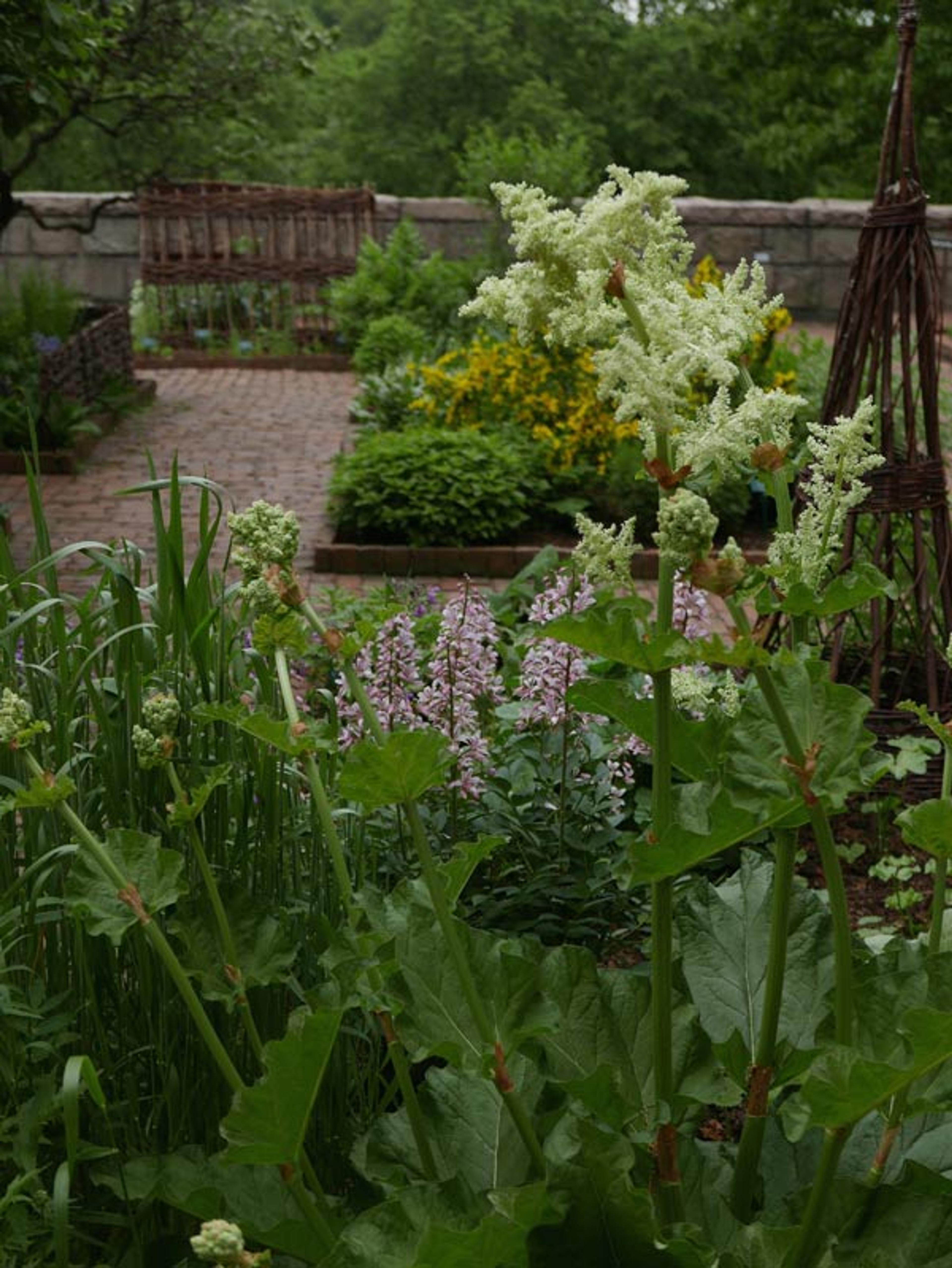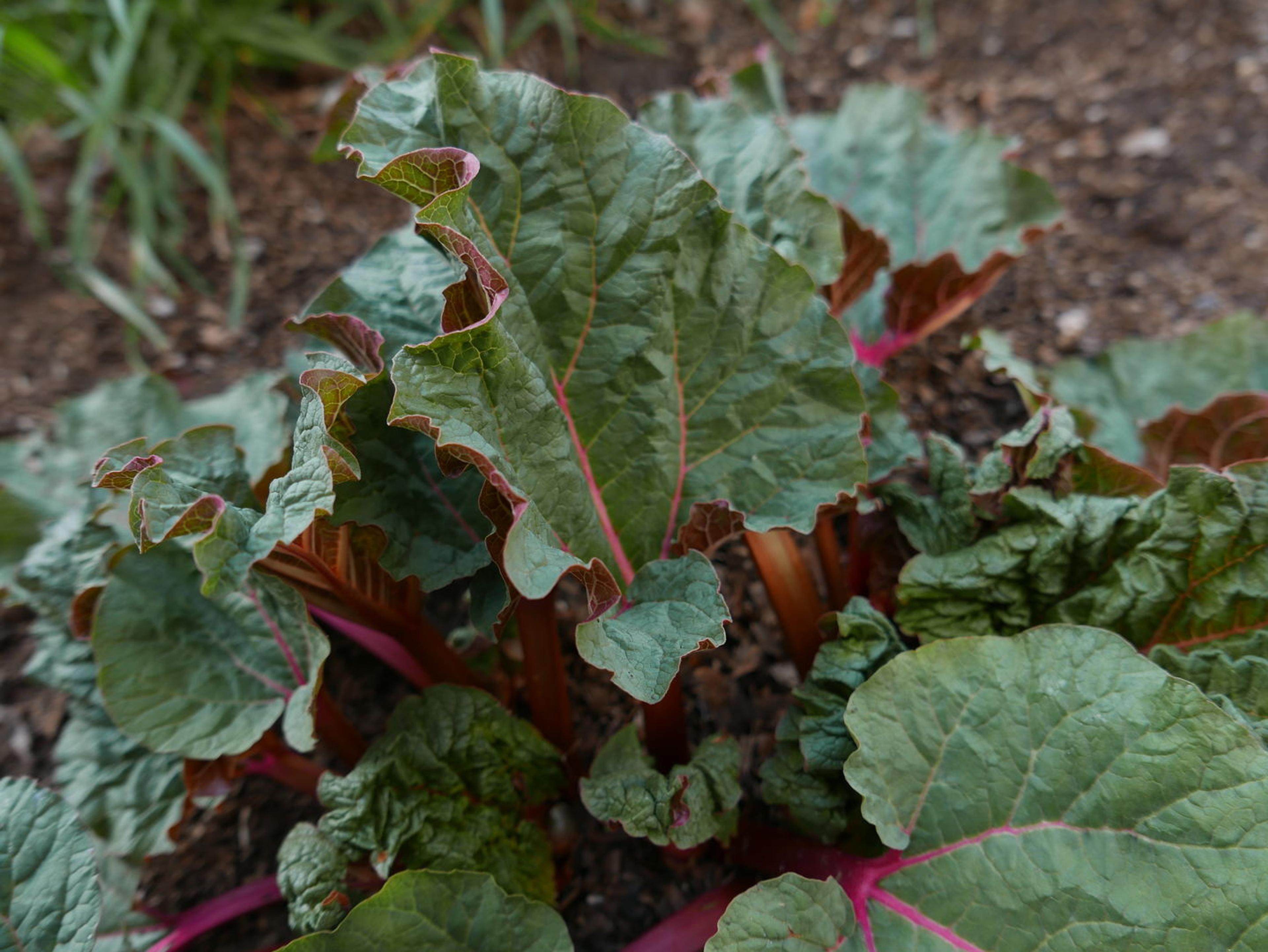
Flowering rhubarb in the Bonnefont Herb Garden. Images courtesy of the author
«For those who appreciate its tart flavor, rhubarb (Rheum rhabarbarum) is a quintessential early summer treat. Stewed with strawberries, infused in summer spritzers, or preserved in jams and chutneys, this vegetable is one of the "fruits" of the season.»
I love rhubarb. This perennial vegetable thrived in the temperate New England climate in which I grew up, and one of my earliest garden memories was in a rhubarb patch. I remember running into the vegetable garden every summer to select the fattest, reddest stalks, and, after peeling away and discarding its poisonous leaves, I would chew on the raw stems until the acidic flavor became too astringent. My sour-craving palate inspired my early childhood foraging, and wood sorrel (Oxalis sp.) and the common sorrel (Rumex sp.) were two other wild plants that provided the mouth-watering, tart flavor I craved. These species all contain varying levels of oxalic acid, which, while dangerous in large quantities, is a culinary delight in smaller doses.

Emerging rhubarb leaves in the Bonnefont Herb Garden
While we do cultivate a number of medieval vegetables in the Bonnefont Herb Garden, rhubarb's alimentary use is not the reason for its presence in the garden. Rhubarb was not enjoyed as a food until well after the Middle Ages, when the abundance of sugar made it more widely palatable. It was actually a powerful medicine that was imported to Western Europe from distant Asia for exorbitant prices. Rhubarb's history as a medicament stretches into antiquity; it has been used medicinally in China for at least two thousand years. Its rhizomes are astringent, laxative, stomachic, and antimicrobial (Van Wyk 270). In medieval medicine, it was considered a panacea recommended for abscesses and wounds and for expelling bile and phlegm (Anderson 268).
In the Bonnefont Herb Garden, we cultivate the medicinal rhubarb (Rheum officinale). While R. officinale and R. palmatum are favored in modern medicine, it appears that several different species were used medicinally during the Middle Ages. Dioscorides discussed what appears to be Rheum rhaponticum, naming it Rha Ponticum, and, in Dictionary of Plant Names for Gardeners: a Handbook on the Origin and Meaning of the Botanical Names of some Cultivated Plants, British botanist William T. Stearn explained this particular nomenclature, stating that the Greek name for root or rhizome was rha and the epithet ponticum referred to Pontus, a region now comprised of modern day Turkey. Dioscorides did not describe the aerial parts of the plant, focusing instead on the texture and color of the root and stressing the importance of roots that were not worm-eaten (Gunther 233). English botanist and horticulturist John Gerard's The Herball, or Generall Historie of Plantes discusses this species as well as the common garden rhubarb (Rheum rhabarbarum). Similarly, Gerard focused on the character and quality of the powdered rhizome, and he asserted that "the best rubarbe is that which is brought from China fresh and new" (Gerard 394).
There are numerous garden-worthy rhubarb species that originate from temperate Asia—many of which are avidly sought after by serious plant collectors. I have successfully grown one such species, Rheum tanguticum, which exhibits gigantic serrated leaves and bears statuesque panicles of flowers. However, one of my favorite species—the striking Rheum nobile—has eluded me. This species' translucent bracts serve as effective greenhouses, protecting the enclosed flower and providing shelter to pollinators—a unique adaptation to its exposed Himalayan habitat.
Sources
Anderson, Frank J., and Adam von Bartsch. "German book illustration through 1500. Herbals through 1500," The Illustrated Bartsch 90, commentary. New York: Abaris Books, 1984.
Gerard, John, and Thomas Johnson. The Herbal or General History of Plants: The Complete 1633 Edition as Revised and Enlarged by Thomas Johnson. New York: Dover Publications, Inc., 1975.
Gunther, Robert T. The Greek Herbal of Dioscorides, translated by John Goodyer, 1655; edited and first printed by Robert T. Gunther, 1933. Reprint: New York: Hafner Publishing, 1968.
Stearn, William T. Stearns Dictionary of Plant Names for Gardeners: a Handbook on the Origin and Meaning of the Botanical Names of some Cultivated Plants. Portland: Timber Press, 1996.
Van Wyk, Ben-Erik, and Michael Wink. Medicinal Plants of the World: an Illustrated Scientific Guide to Important Medicinal Plants and Their Uses. Portland: Timber Press, 2004.